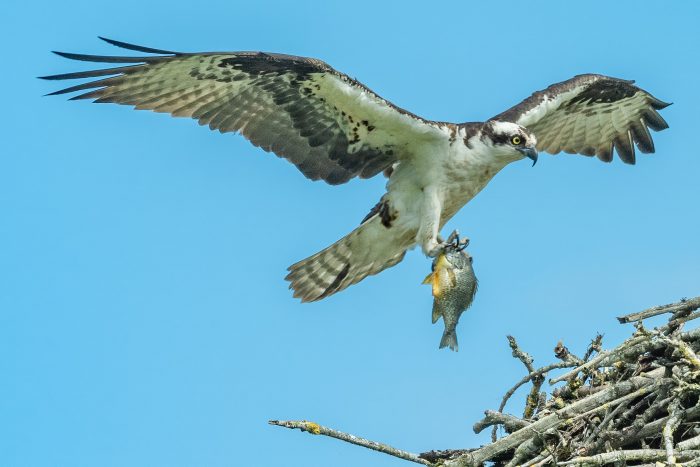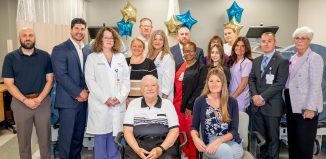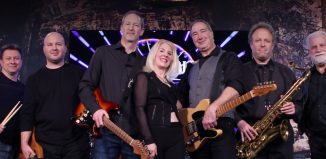Nature Matters: Ospreys and Eagles
By John L. Turner
I vividly remember the first time I saw an Osprey (also called the Fish Hawk due to the fact their diet is, with very rare exception, entirely comprised of fish). As a ten-year-old, a friend and I were birding on the back side of Miller’s Pond in Smithtown, now a county park off of Maple Avenue, but at that time a private estate. We came along the edge of small stream that fed the pond, still hidden a little bit by a shrub thicket of stream-side sweet pepperbush. Peering across the stream we noticed a HUGE bird (isn’t everything bigger when you’re small?) perched on top of a dead tree with an orange object wriggling in its feet. Well, the object was a nice-sized carp, the feet were actually very sharp talons, and the big bird holding the carp was an Osprey.
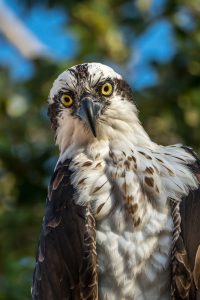
We didn’t realize it at the time but this Osprey sighting was becoming an increasingly uncommon event. Due to the widespread use of DDT, a persistent pesticide that can last in the environment for decades, Ospreys and many other birds higher on the food chain (e.g., Bald eagle, both pelican species, Peregrine falcon) plummeted. Scientists soon learned that the pesticide interfered with the ability of the birds to lay viable eggs, causing some bird populations to decline as mush as 90% and causing the extinction of the eastern United State race of the Peregrine falcon.
Fortunately, in one of the first great environmental victories of the environmentally enlightened era of the early 1970s (you may be old enough to remember the first Earth Day and the adoption of the Clean Water, Clean Air and Endangered Species Acts) DDT was banned in 1972 for use in the United States. The Center of this intense national fight? Right here in the Three Villages where the Environmental Defense Fund (EDF) was established!
Now an international environmental organization focusing on global environmental issues such as climate change and loss of biodiversity, EDF started in a modest office, first in Stony Brook (in a cramped second floor office above the Post Office, ironically, behind the flapping Bald eagle) and then in a house in Setauket on Old Town Road, where it successfully took on the fight to stop the use of this bird-killing pesticide. This several year struggle is chronicled in the highly informative and readable book DDT Wars, written by Charlie Wurster, a retired Stony Brook University professor, EDF board member, and long time resident of Old Field.
Over the past couple of decades Ospreys have bounced back big time throughout North America with an estimated 30,000 pairs (making the continent the global stronghold for the species), an increase mirrored on Long Island with several hundred pairs of Ospreys and growing (as a result the Osprey has been removed from the New York State list of Endangered and Threatened Species).
Helping to fuel this growth are the presence of several coastal fish species including alewife, American Eel, but especially menhaden (or bunker) which has undergone a resurgence in the past half a decade due to a ban on their commercial harvest in New York State waters.
As with an animal that routinely dives into water to catch highly slippery prey, Ospreys have evolved a number of adaptations that provide the tools for a successful hunt. Their sharp talons are instrumental in holding onto fish but their feet have two other adaptations. The skin on the bottom of their feet are pocked with small bumps known as spicules that impart a sandpaper-like quality to the skin, aiding the bird in gripping the fish. And the osprey can rotate one of its three front talons to swing to the back so the bird can better hold onto the fish with a two-in-front, two-in-back talon arrangement. Oh, and did I mention they close their nostrils to keep water out when diving for prey?
Their plumage, too, is adapted to emersion in water. Ospreys have the oiliest feathers of any bird-of-prey, the oil helping to repel water. This oil imparts a musty smell to museum skins, a trait that museum curators have occasionally noted. After Ospreys take-off from a plunge they almost always shake their bodies like a golden retriever, as the water drops easily shed from their highly waterproofed feathers.
Their bulky stick nests are a common and iconic site in many coastal areas of Long Island, sometimes built in sturdy trees, others on buoys, lighthouses, or channel markers. Most often, though, the nests are on elevated platforms some caring individual or organization has erected (if you put up a nesting platform make sure to install a predator guard and one or more perches angled from the side of the platform).
From the ground it is hard to see the contour of the nest but from above you can discern its shallow bowl shape, containing softer material such as phragmites, finer sticks and even seaweed, which line the bowl. Ospreys are notorious for adding human-made objects to their nest with dozens of items being documented; we don’t have an understanding of why they do this; maybe they just like to collect things like rope, net fragments, rubber boots, items of clothing, even children’s dolls!
Osprey chicks in various stages of development are in nests all around Long Island now. Both parents incubate the eggs (two to three in a typical clutch, although occasionally a four-egg nest is reported). If the hatchlings make it through the wind and rain at their exposed nest sites, they grow rapidly, fledging in about two months. If you want to watch Ospreys go through nest building, incubation, and raising of young there are a number of webcams on-line in which to view ospreys.
PSEG has two productive webcams to enjoy, one in Oyster Bay and the other on the south side of Main Street in Patchogue Village. As I write this I’m listening to the piercing call of an adult Osprey vocalizing from the webcam nest in Oyster Bay; two small young have hatched and there’s an unhatched egg that hopefully will hatch very soon. The two young in the Patchogue nest are several days older.
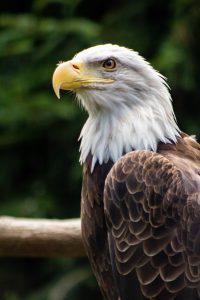
A larger cousin to the Osprey — the Bald Eagle — is another beneficiary of the DDT ban and as the eagle has resurged throughout the country, so too on Long Island. As a result of this population growth the species was removed in 2007 from the federal Endangered Species List, although it is still listed as a Threatened Species in New York DEC’s list. While largely free from pesticide contamination concerns, many Bald and Golden Eagles today face poisoning from a different source — lead. The lead is ingested from spent shot, bullet fragments, and perhaps even long lost fishing sinkers first ingested by waterfowl they preyed upon.
Sightings of adult and immature eagles have become almost commonplace, especially near areas where they nest. The first eagle nest, evidence of this comeback, was discovered on Gardiner’s Island in 2006 and for several years was the sole nest on Long Island. (In fact, prior to the current resurgence, the last Bald Eagle nest was on Gardiner’s Island way back in 1932.) But by 2015 the number of nests had climbed to five and by 2018 reached eight. Now there are more than a dozen nests. The nest in Centerport, just north of State Route 25A and west of the harbor, is perhaps the most conspicuous. Good views of the eagle nest at the William Floyd Estate can be gained, looking south across Home Creek, from the Town of Brookhaven’s Osprey Park.
As with the scientific name of many species, the Bald Eagle’s scientific name imparts information about the species; Haliaeetus leucocephalus means the sea eagle with the white-head.
The resurgence of these two impressive birds-of-prey, over the past several decades, has been inspirational, not only for the grace, power, and beauty they add to our daily experience, but also because they are living proof that if we do the right things — banning poisons (let’s take the next step in their restoration by working with hunters to get the lead out!), cleaning our nation’s waters, protecting their food supply, and providing nest sites — these birds and nature can begin the healing process and meet us halfway. These birds present, indeed, impart to us an important and valuable lesson in this time of planetary peril. It’s up to each of us to learn from them — what say you, are you willing to embrace the lesson?
A resident of Setauket, John Turner is conservation chair of the Four Harbors Audubon Society, author of “Exploring the Other Island: A Seasonal Nature Guide to Long Island” and president of Alula Birding & Natural History Tours.

